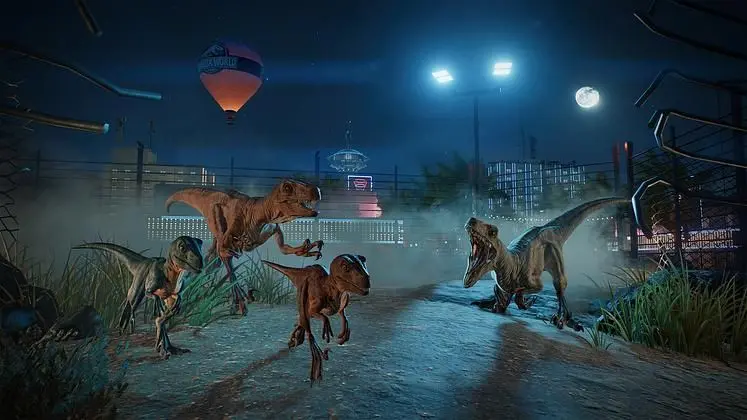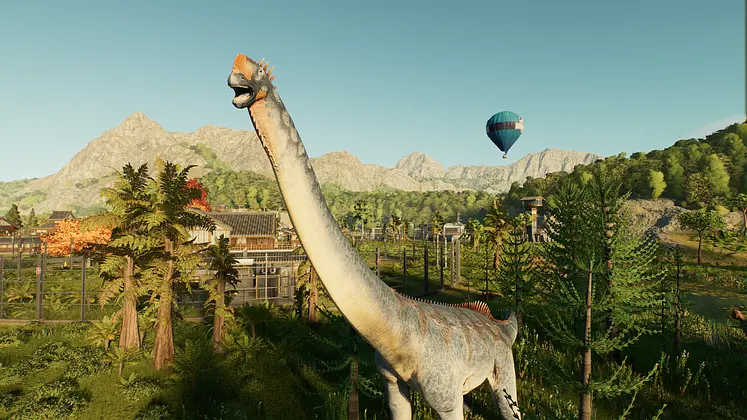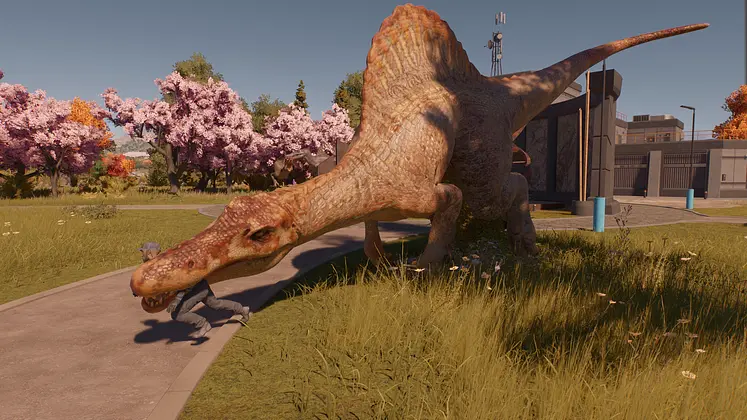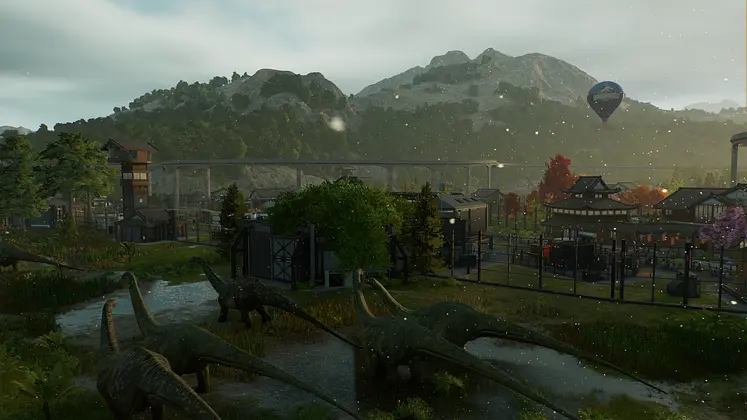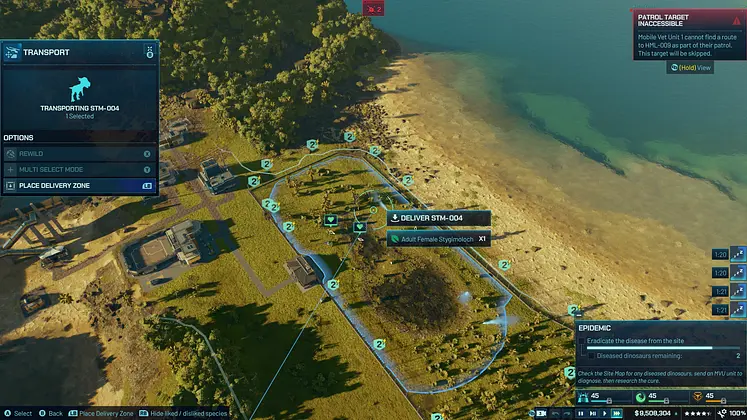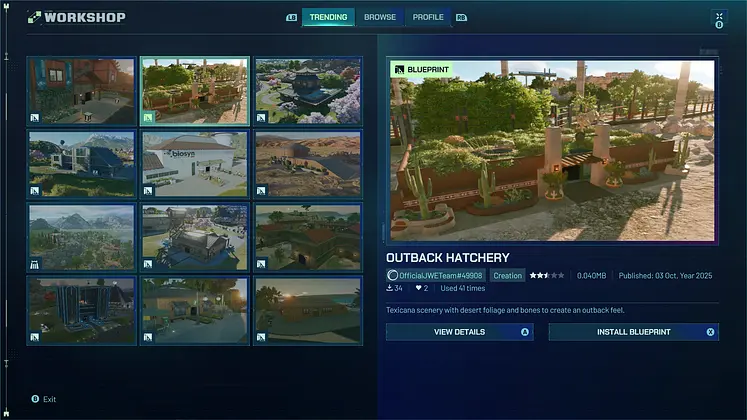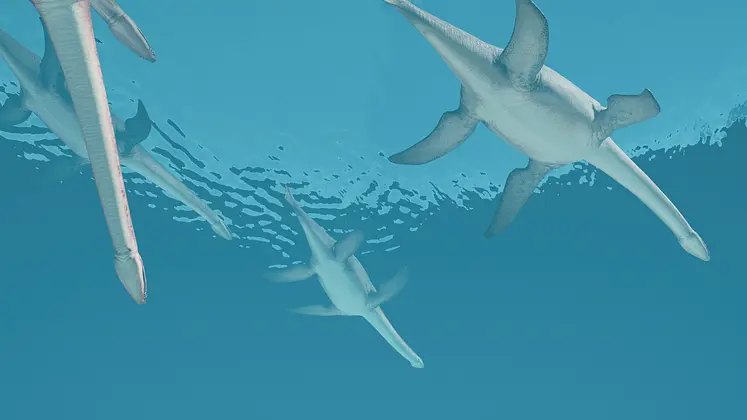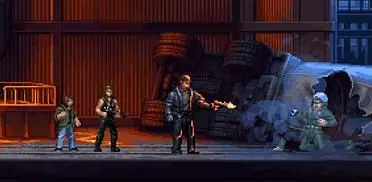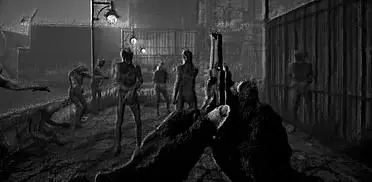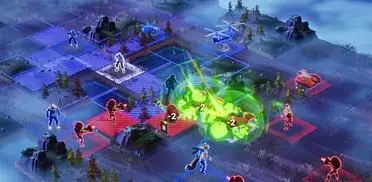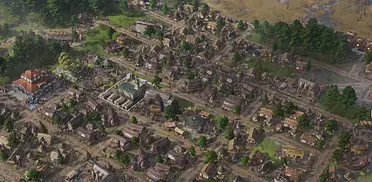The announcement of a third Jurassic World Evolution game earlier this year came as no surprise. The past two entries convinced millions of players (and most critics) the post-2015 franchise refresh deserved expansive park management sims which put its dinosaurs and other prehistoric animals to good use. Following two commendable but flawed efforts, Jurassic World Evolution 3 feels like the culmination of everything that Frontier has done so far.
Following my hands-on preview with the game and a brief chat with two principal designers, I had many reasons to be optimistic about this one. Though I had tons of nostalgic fun with the other two installments, lingering base-level problems with the amount of management involved (which detracted from the dinos) and a weird lack of creative tools that other Frontier-developed management sims had already cracked long ago made the Evolution series less than it was destined to be. Thankfully, the devs have paid attention to most of the community feedback following Evolution 2, and the result is glorious.
Jurassic World Evolution 3 takes us right into the post-Dominion state of the world with yet another canon-adjacent storyline: Led by Evolution series veteran Cabot Finch (still as funny and annoying as ever) and a roster of old and new secondary characters, DIN (Dinosaur Integration Network) is tasked with helping dinosaurs and humans coexist, turning failed park sites into operational locations where the animals can thrive while we marvel at them. A couple of teases connect with Jurassic World Rebirth’s premise that most of these creatures are failing to adapt in the non-tropical parts of the world, which suggests a movie tie-in DLC sooner rather than later, but the base game takes aspiring park managers around the globe regardless.
When compared to Evolution 2’s short and tutorial-like campaign, the story-driven part of the game is an immediate improvement. It takes the flexible structure of Evolution 1 and greatly expands on the idea, presenting ten distinct locations (one of them has been kept a surprise), each with a unique set of challenges and even puzzle-like layouts that push players to figure out different ways to plan and build parks that can satisfy shifting needs. While Jurassic World Evolution 3 remains a park management sim through and through, the ‘flavor’ of each location has been enough to convince me to 5-star them as soon as I can following the review period. Of course, Ian Malcolm’s occasional yapping (once again voiced by Jeff Goldblum) makes the whole journey more entertaining.
This directly ties into the game’s more thought-out overarching design: New facilities and devices like the maintenance building or security cameras can keep track of (and take care of) everyday occurrences like the power grid failing or a Tyrannosaurus Rex breaking through a fence. You know, the usual when you’re in charge of many Jurassic Parks at once. Instead of having to micromanage tens of small tasks while also trying to navigate park expansion matters and perilous finances, smart planning rewards you with some peace of mind knowing that workers can keep the park operational for you.
Having some returning systems and mechanics – such as the black market or herding – from Evolution 2’s most celebrated DLCs also helps smooth out many old annoyances. When coupled with the juveniles and family units at the center of the marketing, the end result is having access to more options to deal with the parks’ appeal ratings or creatures dying of old age just as you’re trying to bounce back from a bad financial spot. At first glance, breeding mostly adds to the realistic simulations of prehistoric life, but after a while, you’ll realize letting dinosaurs have offsprings is a cheaper alternative to having to create or buy new assets every time an enclosure is feeling empty and/or the crowd asks for new thrills.
Similarly, having balloon tours and the Cretaceous Cruise from the first Jurassic World movie (on top of every past attraction) in enabled me to save some space while trying to up my ‘dino coverage’ and improve the transport rating. As much as I like the monorail towering over enclosures, it’s not the best option to move guests around in some of the thinner maps you’ll encounter. These are just some examples; even when trying to make parks work better, we just have access to more and better options. This philosophy also turns Challenge mode into more than a personal race against the clock and difficulties across every location in the game; this time around, a unique challenge has been built around each map, which reminded me of Jurassic Park: Operation Genesis’ missions.
Even the shockingly deep and greatly reworked terrain and scenery tools can be used to make your life as a park manager easier: If disaster strikes too often and keeping tens of carnivores in check during storms proves difficult, have you considered keeping fences to a minimum and letting natural barriers do their job? It’s easier (and cheaper) to spend some time creating valleys and limiting fences to small sections your rangers and other teams can cross. Just a thought. What about actual deep-water rivers? Tinker with those tools for a bit and you’ll be surprised by how much the maps can be altered.
Small quality-of-life changes like the ability to instantly see the animals’ environmental needs as you plant adequate vegetation or change the terrain are also useful. Planning to add a pack of raptors to an enclosure where the seemingly invulnerable giant sauropods already roam in peace? You’ll automatically get icons telling you whether it’s a good or bad idea before you screw everything up.
All this attention to small quirks and recurring annoyances from past entries makes the minimal rework of the scientist system baffling. While specialists are less expensive and less prone to getting tired after just a bunch of small tasks, having them affect so many systems with no enjoyment or different results to be gained… is annoying. Just a bonus layer of work required to get things done and the sort of empty padding that sunk many management sims in the past. In Evolution 3, this design decision only makes a scratch on the ship because everything else is smart, but I know most players won’t be happy to see them return.
Of course, the Sandbox mode is where players will spend most of their time, especially after the inclusion of an island generator (in case all the pre-made locations and clean square maps aren’t enough) that can produce some really striking layouts and absurdly dense jungles. And in case you don’t have enough with your own creations, entire parks can be shared online (and across all platforms) alongside custom buildings and all sorts of scenery blueprints. Think of Planet Coaster 2’s best part but Jurassic, with the main difference being Evolution 3 presents both the creation and sharing tools in a less obtuse way. I assume many players won’t have the time to really dig into what they can create from scratch (or how they can greatly modify what’s already in there), but being able to download all sorts of new content for the game with just one click will fuel Evolution 3 for years to come. We might not even need Evolution 4 once the more talented diehards get to work.
All the extra bells and whistles when it comes to decorations don’t take away from the stars of the show: The dinosaurs, marine reptiles, pterosaurs, and whatnot are lovingly rendered and animated, with special attention paid to bump maps, how lighting interacts with them, and how they interact with each other. No dino-on-dino steamy time to make extremely cute babies though. The end result is the best representation of dinosaurs and other prehistoric creatures in any video game so far. Paleo-fanatics won’t be leaving the photo mode anytime soon, but be warned: the camera misbehaves when geometry gets in the way.
None of this matters if the game runs into performance problems the moment you start to tinker with the creative tools and think bigger, yet I found the PC experience at 2K (I have a mid-tier build by 2025’s standards) to be one of the smoothest in quite a bit. Frontier has mastered its Cobra Engine to a higher degree, and the results speak for themselves. Even recent advancements like ray-traced global illumination and shadows, as well as the often hiccup-y DLSS frame generation, do exactly what they’re supposed to do without issue. Perhaps more surprising is how light on the CPU it is despite all the complex simulations involved in late parks; the GPU is put through its paces though.
While I’m sure some players might still be put off by the most demanding sections of what remains a management-heavy video game outside of the Sandbox mode with the creative ruleset, Jurassic World Evolution 3 strikes a near-perfect balance between the challenge that’s expected and the room for player expression and creativity managers have pushed for over the two past games. It’s huge, ambitious, and future-proofed in a way few park builders and management sims are, to the point I’ve been left wondering whether this is Frontier’s Jurassic swansong once the free updates and paid DLCs are done. If that’s the case, this is a very high note to end on.
Jurassic World Evolution 3 is now available on PC (Steam, Windows Store, Epic Games Store), PS5, and Xbox Series X/S starting at $59,99 (Standard Edition).
JURASSIC WORLD EVOLUTION 3 VERDICT
Free from last gen’s technical limitations and focused on creative control, Jurassic World Evolution 3 is the ultimate Jurassic Park video game and a culmination of Frontier’s entire body of work.
TOP GAME MOMENT
Creating an operational natural valley enclosure without any fences.
Good vs Bad
- Gorgeous audiovisual presentation that uses recent graphical advancements
- Steady and smooth performance across all its modes on PC
- Lengthy and varied campaign that’s fun to fully complete
- Reworked Challenge mode with a unique twist for each location
- Family units and new animal behaviors add layers to the simulation
- Astounding set of creative tools that will keep the game fresh for years
- A stronger focus on sandbox gameplay and less restrictive park layouts
- More options to painlessly deal with menial tasks
- While improved, scientists remain annoying and only serve as padding
- The camera can be hard to control under certain conditions
